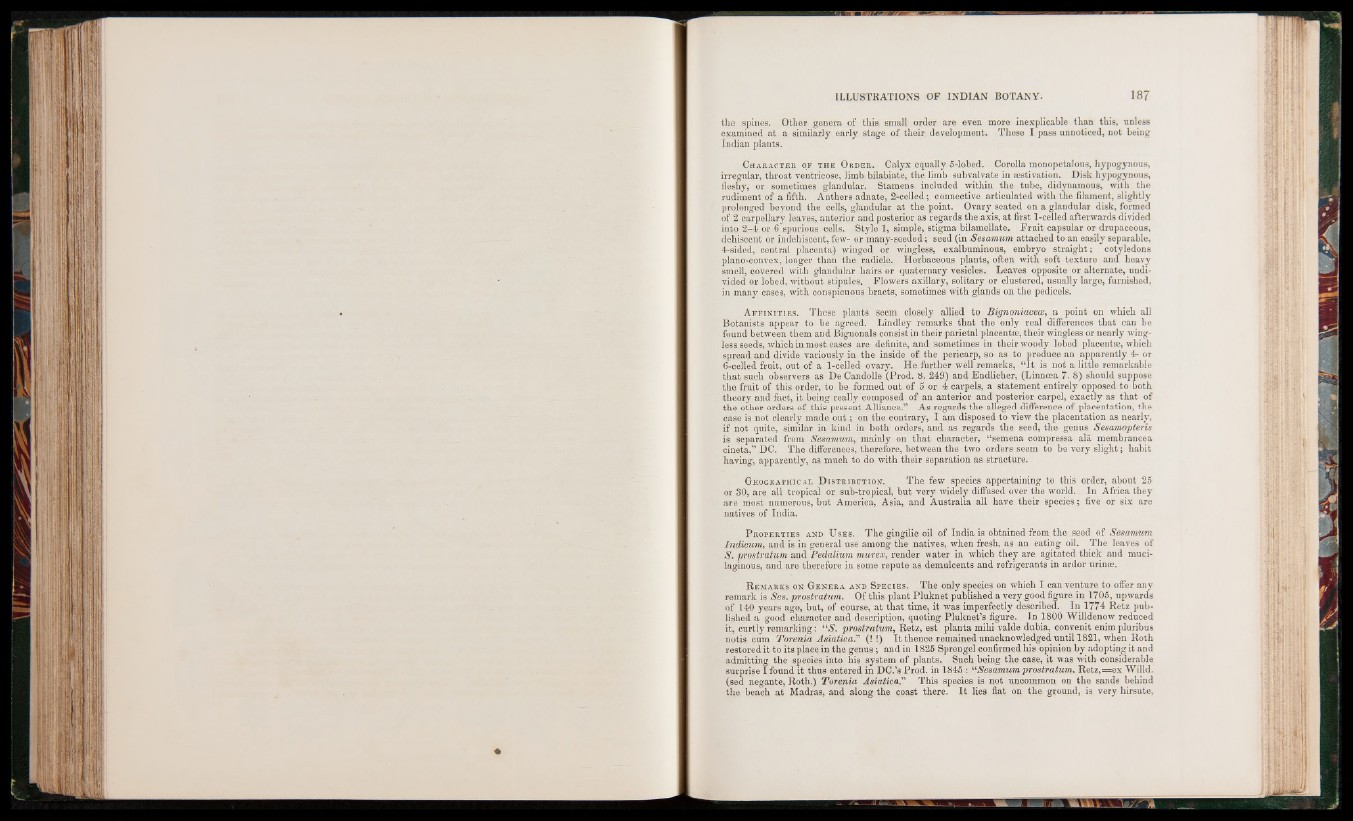
the spines. Other genera of this small order are even more inexplicable than this, unless
examined at a similarly early stage of their development. These I pass unnoticed, not being
Indian plants.
Character of the O rder. Calyx equally 5-lobed. Corolla monopetalous, hypogynous,
irregular, throat ventricose, limb bilabiate, the limb subvalvate in aestivation. Disk hypogynous,
fleshy; or sometimes glandular. Stamens included within the tube, didynamous, with the
rudiment of a fifth. Anthers adnate, 2-celled ; connective articulated with the filament, slightly
prolonged beyond the cells, glandular at the point. Ovary seated on a glandular disk, formed
of 2 carpellary leaves, anterior and posterior as regards the axis, at first 1-celled afterwards divided
into 2-4 or 6 spurious cells. Style 1, simple, stigma bilamellate. Fruit capsular or drupaceous,
dehiscent or indéhiscent, few- or many-seeded ; seed (in Sesamum attached to an easily separable,
4-sided, central placenta) winged or wingless, exalbuminous, embryo straight; cotyledons
plano-convex, longer than the radicle. Herbaceous plants, often with soft texture and heavy
smell, covered with glandular hairs or quaternary vesicles. Leaves opposite or alternate, undivided
or lobed, without stipules. Flowers axillary, solitary or clustered, usually large, furnished,
in many cases, with conspicuous bracts, sometimes with glands on the pedicels.
Af f in it ies . These plants seem closely allied to Bignoniacece, a point on which all
Botanists appear to be agreed. Lindley remarks that the only real differences that can be
found between them and Bignonals consist in their parietal placentae, their wingless or nearly wingless
seeds, which in most cases are definite, and sometimes in their woody lobed placentae, which
spread and divide variously in the inside of the pericarp, so as to produce an apparently 4- or
6-celled fruit, out of a 1-celled ovary. He further wèll remarks, “It is not a little remarkable
that such observers as De Candolle (Prod. 8. 249) and Endlicher, (Linncea 7. 8) should suppose
the fruit of this order, to be formed out of 5 or 4 carpels, a statement entirely opposed to both
theory and fact, it being really composed of an anterior and posterior carpel, exactly as that of
the other orders of this present Alliance.” As regards the alleged difference of placentation, the
case is not clearly made out ; on the contrary, I ani disposed to view the placentation as nearly,
if not quite, similar in kind in both orders, and as regards the seed, the genus Sesamopteris
is separated from Sesamum, mainly on that character, “semena compressa alâ membrancea
cineta,” DC. The differences, therefore, between the two orders seem to be very slight ; habit
having, apparently, as much to do with their separation as structure.
Geographical D istribution. The few species appertaining to this order, about 25
or 80, are all tropical or sub-tropical, but very widely diffused over the world.. In Africa they
are most numerous, but America, Asia, and Australia all have their species ; five or six are
natives of India.
P roperties and U ses. The gingilie oil of India is obtained from the seed of Sesamum
Indicum, and is in general usé among the natives, when fresh, as an eating oil. The leaves of
S. prostratum and Pedalium murex, render water in which they are agitated thick and mucilaginous,
and are therefore in some repute as demulcents and refrigerants in ardor urinæ.
R emarks on Genera and Species. The only species on which I can venture to offer any
remark is Ses. prostratum. Of this plant Pluknet published a very good figure in 1705, upwards
of 140 years ago, but, of course, at that time, it was imperfectly described. In 1774 Retz published
a good character and description, quoting Pluknet’s figure. In 1800 Willdenow reduced
it, curtly remarking : “S. prostratum, Retz, est planta mihi valde dubia, convenit enim pluribus
notis cum Torenia Asiatica.” (! !) I t thence remained unacknowledged until 1821, when Roth
restored it to its place in the genus ; and in 1825 Sprengel confirmed his opinion by adopting it and
admitting the species into his system of plants. Such being the case, it was with considerable
surprise I found it thus entered in DC.’s Prod, in 1845 : “Sesamum prostratum, R etz,=ex Willd.
(sed negante, Roth.) Torenia Asiatica.” This species is not uncommon on the sands behind
the beach at Madras, and along the coast there. I t lies flat on the ground, is very hirsute,